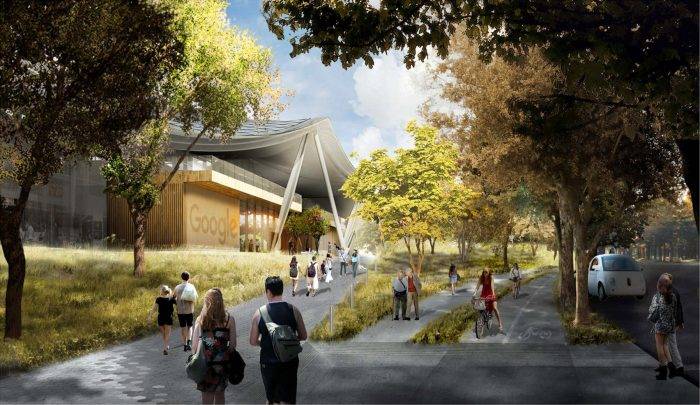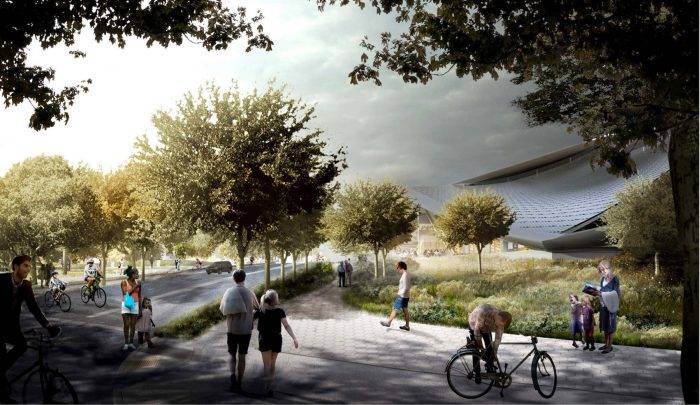 Perhaps the most pervasive and enduring myth about the office is that it is somehow dying off. It’s a blast of guff originally farted out at the dawn of the technological revolution in the early 1990s, which has somehow lingered and been stinking the place out ever since. The essential premise behind the idea of the death of the office is that mobile technology makes it possible for us to work from ‘anywhere’ and so that must mean ‘somewhere’ is no longer needed.
Perhaps the most pervasive and enduring myth about the office is that it is somehow dying off. It’s a blast of guff originally farted out at the dawn of the technological revolution in the early 1990s, which has somehow lingered and been stinking the place out ever since. The essential premise behind the idea of the death of the office is that mobile technology makes it possible for us to work from ‘anywhere’ and so that must mean ‘somewhere’ is no longer needed.
It’s an alluring idea, partly because it seems reasonable enough so is especially attractive if you’re looking to make some bold statement about office design based on very little evidence or if you have a vested interest in getting more people to buy into the idea that it’s a goner.
That is why you’ll hear it most from PR people, journalists who haven’t the time or inclination to look into the subject properly – and technology and telecoms companies.
The office has an enduring appeal for a number of reasons. One of the most commonly cited is simply that people and companies both prefer it. For employees, even the drudge of commuting, routine, noise, interruptions, annoying colleagues and lack of work life balance may be seen as a lesser evil than the idea of sitting at home, alone, for long periods. For employers, the appeal lies in creating a single identity and culture for the organisation or –if you want to be cynical – a panopticon with which to keep an eye on people.
 That is not to say there isn’t a balance to be struck, and we should be grateful we have the opportunity to work in a choice of ways. There’s no doubt, also, that there are certain business imperatives for the uptake of flexible working including better recruitment and retention, sometimes increased productivity, work-life balance and helping parents manage their careers alongside their other responsibilities.
That is not to say there isn’t a balance to be struck, and we should be grateful we have the opportunity to work in a choice of ways. There’s no doubt, also, that there are certain business imperatives for the uptake of flexible working including better recruitment and retention, sometimes increased productivity, work-life balance and helping parents manage their careers alongside their other responsibilities.
On the other hand, there are a number of well understood and researched reasons for us not to discard offices just yet. One is that people communicate better when they are in physical proximity to each other, a fact repeatedly underpinned by researchers such as Tom Allen at MIT.
Nothing propinks like propinquity
Another reason is based on the idea that “nothing propinks like propinquity”, which means that nothing fosters a close relationship better than proximity. While this phrase is often attributed to George Ball, a US Undersecretary of State in JFK’s and LBJ’s administrations, Ian Fleming used it as a chapter title in Diamonds are Forever. It’s true that Ball popularised the idea in politics where it came to be known as the Ball Rule of Power which states that ‘the more direct access you have to the president, the greater your power, no matter what your title actually is’.
This idea is also supported by research from MIT. It was first theorised by psychologists Leon Festinger, Stanley Schachter, and Kurt Back in the 1960s and has been tested a number of times down the years, not least with regard to the way that working in close proximity to other people often leads to romantic attractions. In fact, research also shows that people who meet at work not only have more chance of getting married, but also less chance of getting divorced.
One surprising aspect of this is that, as well as developing stronger interpersonal relationships, people can end up mirroring the attitudes of those around them. This can have both positive and negative effects, of course, depending on what those attitudes are. For example, according to a study published this month by the Rotterdam School of Management, middle managers ape the ethics of their bosses, regardless of how ethical they are themselves,
 The study found that this trickles down the organisation because unethical leadership at the top of an organisation is more likely to lead to middle managers treating their subordinates unfairly if the social and spatial distance between them and the top management is low.
The study found that this trickles down the organisation because unethical leadership at the top of an organisation is more likely to lead to middle managers treating their subordinates unfairly if the social and spatial distance between them and the top management is low.
In contrast, the effect is reversed if the social and spatial distance between managers and top management is high. Middle managers, who are unfairly treated by their bosses, will treat their employees more fairly if, for example, they are based in different offices or buildings from their managers, and the social distance is high.
These are the forces that generate the gravitational pull of the office, which are at least as powerful as those that pull us away from its embrace. Even when we don’t fully understand how their pulls resolve themselves in practice, we at least have an intuition that they exist. This intuition of these forces is what drives us to keep creating and occupying the same physical spaces as other people. This is true even for those people such as the self employed who can work freely at home but instead increasingly choose to work in co-working spaces or join co-working hubs.
Those that deny the truth of this and insist on pronouncing the death of the office are ignoring the forces that drive us as human beings to work together and the important facts that a) we like it and b) it works. Mostly.
Images: renders of the design for Google’s new headquarters offices in Mountainview














August 16, 2018
The office will always live on because nothing propinks like propinquity
by Mark Eltringham • Comment, Property, Workplace design
It’s an alluring idea, partly because it seems reasonable enough so is especially attractive if you’re looking to make some bold statement about office design based on very little evidence or if you have a vested interest in getting more people to buy into the idea that it’s a goner.
That is why you’ll hear it most from PR people, journalists who haven’t the time or inclination to look into the subject properly – and technology and telecoms companies.
The office has an enduring appeal for a number of reasons. One of the most commonly cited is simply that people and companies both prefer it. For employees, even the drudge of commuting, routine, noise, interruptions, annoying colleagues and lack of work life balance may be seen as a lesser evil than the idea of sitting at home, alone, for long periods. For employers, the appeal lies in creating a single identity and culture for the organisation or –if you want to be cynical – a panopticon with which to keep an eye on people.
On the other hand, there are a number of well understood and researched reasons for us not to discard offices just yet. One is that people communicate better when they are in physical proximity to each other, a fact repeatedly underpinned by researchers such as Tom Allen at MIT.
Nothing propinks like propinquity
Another reason is based on the idea that “nothing propinks like propinquity”, which means that nothing fosters a close relationship better than proximity. While this phrase is often attributed to George Ball, a US Undersecretary of State in JFK’s and LBJ’s administrations, Ian Fleming used it as a chapter title in Diamonds are Forever. It’s true that Ball popularised the idea in politics where it came to be known as the Ball Rule of Power which states that ‘the more direct access you have to the president, the greater your power, no matter what your title actually is’.
This idea is also supported by research from MIT. It was first theorised by psychologists Leon Festinger, Stanley Schachter, and Kurt Back in the 1960s and has been tested a number of times down the years, not least with regard to the way that working in close proximity to other people often leads to romantic attractions. In fact, research also shows that people who meet at work not only have more chance of getting married, but also less chance of getting divorced.
One surprising aspect of this is that, as well as developing stronger interpersonal relationships, people can end up mirroring the attitudes of those around them. This can have both positive and negative effects, of course, depending on what those attitudes are. For example, according to a study published this month by the Rotterdam School of Management, middle managers ape the ethics of their bosses, regardless of how ethical they are themselves,
In contrast, the effect is reversed if the social and spatial distance between managers and top management is high. Middle managers, who are unfairly treated by their bosses, will treat their employees more fairly if, for example, they are based in different offices or buildings from their managers, and the social distance is high.
These are the forces that generate the gravitational pull of the office, which are at least as powerful as those that pull us away from its embrace. Even when we don’t fully understand how their pulls resolve themselves in practice, we at least have an intuition that they exist. This intuition of these forces is what drives us to keep creating and occupying the same physical spaces as other people. This is true even for those people such as the self employed who can work freely at home but instead increasingly choose to work in co-working spaces or join co-working hubs.
Those that deny the truth of this and insist on pronouncing the death of the office are ignoring the forces that drive us as human beings to work together and the important facts that a) we like it and b) it works. Mostly.
Images: renders of the design for Google’s new headquarters offices in Mountainview